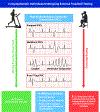Exercise-Induced Ventricular Ectopy and Cardiovascular Mortality in Asymptomatic Individuals
- PMID: 34857087
- PMCID: PMC8720278
- DOI: 10.1016/j.jacc.2021.09.1366
Exercise-Induced Ventricular Ectopy and Cardiovascular Mortality in Asymptomatic Individuals
Abstract
Background: The prognosis of exercise-induced premature ventricular contractions (PVCs) in asymptomatic individuals is unclear.
Objectives: This study sought to investigate whether high-grade PVCs during stress testing predict mortality in asymptomatic individuals.
Methods: A cohort of 5,486 asymptomatic individuals who took part in the Lipid Research Clinics prospective cohort had baseline interview, physical examination, blood tests, and underwent Bruce protocol treadmill testing. Adjusted Cox survival models evaluated the association of exercise-induced high-grade PVCs (defined as either frequent (>10 per minute), multifocal, R-on-T type, or ≥2 PVCs in a row) with all-cause and cardiovascular mortality.
Results: Mean baseline age was 45.4 ± 10.8 years; 42% were women. During a mean follow-up of 20.2 ± 3.9 years, 840 deaths occurred, including 311 cardiovascular deaths. High-grade PVCs occurred during exercise in 1.8% of individuals, during recovery in 2.4%, and during both in 0.8%. After adjusting for age, sex, diabetes, hypertension, lipids, smoking, body mass index, and family history of premature coronary disease, high-grade PVCs during recovery were associated with cardiovascular mortality (hazard ratio [HR]: 1.82; 95% CI: 1.19-2.79; P = 0.006), which remained significant after further adjusting for exercise duration, heart rate recovery, achieving target heart rate, and ST-segment depression (HR: 1.68; 95% CI: 1.09-2.60; P = 0.020). Results were similar by clinical subgroups. High-grade PVCs occurring during the exercise phase were not associated with increased risk. Recovery PVCs did not improve 20-year cardiovascular mortality risk discrimination beyond clinical variables.
Conclusions: High-grade PVCs occurring during recovery were associated with long-term risk of cardiovascular mortality in asymptomatic individuals, whereas PVCs occurring only during exercise were not associated with increased risk.
Keywords: cardiac arrhythmia; cardiovascular disease; heart disease; premature ventricular contraction; stress test; ventricular ectopy.
Copyright © 2021 American College of Cardiology Foundation. Published by Elsevier Inc. All rights reserved.
Conflict of interest statement
Funding Support and Author Disclosures Dr Gharios was supported by the Fogarty International Center and Office of Dietary Supplements of the National Institutes of Health under Award Number D43 TW009118 via the Scholars in HeAlth Research Program (SHARP) at the American University of Beirut. Dr Mora was supported by NHLBI K24HL 136852. The funders had no role in the design or conduct of the study; in the collection, analysis, and interpretation of the data; and in the preparation, review, or approval of the manuscript. Dr Mora has served as a consultant to Pfizer and Quest Diagnostics for work unrelated to the current study. All other authors have reported that they have no relationships relevant to the contents of this paper to disclose.
Figures



Comment in
-
Premature Ventricular Complexes During Exercise in Asymptomatic Adults: Do They Deserve a Closer Look?J Am Coll Cardiol. 2021 Dec 7;78(23):2278-2280. doi: 10.1016/j.jacc.2021.09.1365. J Am Coll Cardiol. 2021. PMID: 34857088 No abstract available.
Similar articles
-
Prognostic Significance of Different Ventricular Ectopic Burdens During Submaximal Exercise in Asymptomatic UK Biobank Subjects.Circulation. 2023 Dec 12;148(24):1932-1944. doi: 10.1161/CIRCULATIONAHA.123.064633. Epub 2023 Oct 19. Circulation. 2023. PMID: 37855144 Free PMC article.
-
Ventricular arrhythmias during clinical treadmill testing and prognosis.Arch Intern Med. 2008 Jan 28;168(2):225-34. doi: 10.1001/archinte.168.2.225. Arch Intern Med. 2008. PMID: 18227372
-
Ventricular ectopy during treadmill exercise stress testing in the evaluation of long QT syndrome.Heart Rhythm. 2008 Dec;5(12):1690-4. doi: 10.1016/j.hrthm.2008.08.038. Epub 2008 Sep 4. Heart Rhythm. 2008. PMID: 19084807 Free PMC article.
-
Prognostic implications of stress test-induced arrhythmias: a systematic review and meta-analysis.Open Heart. 2025 Mar 28;12(1):e003133. doi: 10.1136/openhrt-2024-003133. Open Heart. 2025. PMID: 40154976 Free PMC article.
-
Revisiting exercise-induced premature ventricular complexes as a prognostic factor for mortality in asymptomatic patients: A systematic review and meta-analysis.Front Cardiovasc Med. 2022 Sep 29;9:949694. doi: 10.3389/fcvm.2022.949694. eCollection 2022. Front Cardiovasc Med. 2022. PMID: 36247448 Free PMC article.
Cited by
-
Survived sudden cardiac death in a patient with arrhythmic mitral valve prolapse syndrome: a case report.Clin Res Cardiol. 2023 Dec;112(12):1860-1865. doi: 10.1007/s00392-023-02195-3. Epub 2023 Apr 12. Clin Res Cardiol. 2023. PMID: 37043023 Free PMC article. No abstract available.
-
Prognostic Significance of Different Ventricular Ectopic Burdens During Submaximal Exercise in Asymptomatic UK Biobank Subjects.Circulation. 2023 Dec 12;148(24):1932-1944. doi: 10.1161/CIRCULATIONAHA.123.064633. Epub 2023 Oct 19. Circulation. 2023. PMID: 37855144 Free PMC article.
-
Monitoring and diagnosis of intermittent arrhythmias: evidence-based guidance and role of novel monitoring strategies.Eur Heart J Open. 2022 Nov 12;2(6):oeac072. doi: 10.1093/ehjopen/oeac072. eCollection 2022 Nov. Eur Heart J Open. 2022. PMID: 36440351 Free PMC article. Review.
-
The Association between Exercise-Induced Ventricular Premature Contractions and Long-Term Mortality in Patients without Obstructive Coronary Artery Disease.Acta Cardiol Sin. 2024 May;40(3):267-274. doi: 10.6515/ACS.202405_40(3).20231227A. Acta Cardiol Sin. 2024. PMID: 38779161 Free PMC article.
-
Brazilian Guideline for Exercise Test in the Adult Population - 2024.Arq Bras Cardiol. 2024 Feb;121(3):e20240110. doi: 10.36660/abc.20240110. Arq Bras Cardiol. 2024. PMID: 38896581 Free PMC article. English, Portuguese. No abstract available.
References
-
- Bruce RA, DeRouen TA, Hossack KF. Value of maximal exercise tests in risk assessment of primary coronary heart disease events in healthy men. Five years’ experience of the Seattle heart watch study. Am J Cardiol 1980;46:371–8. - PubMed
-
- Cole CR, Blackstone EH, Pashkow FJ, Snader CE, Lauer MS. Heart-rate recovery immediately after exercise as a predictor of mortality. N Engl J Med 1999;341:1351–7. - PubMed
-
- Gordon DJ, Ekelund LG, Karon JM et al. Predictive value of the exercise tolerance test for mortality in North American men: the Lipid Research Clinics Mortality Follow-up Study. Circulation 1986;74:252–61. - PubMed
-
- Rywik TM, Zink RC, Gittings NS et al. Independent prognostic significance of ischemic ST-segment response limited to recovery from treadmill exercise in asymptomatic subjects. Circulation 1998;97:2117–22. - PubMed
-
- Jouven X, Zureik M, Desnos M, Courbon D, Ducimetière P. Long-term outcome in asymptomatic men with exercise-induced premature ventricular depolarizations. N Engl J Med 2000;343:826–33. - PubMed

